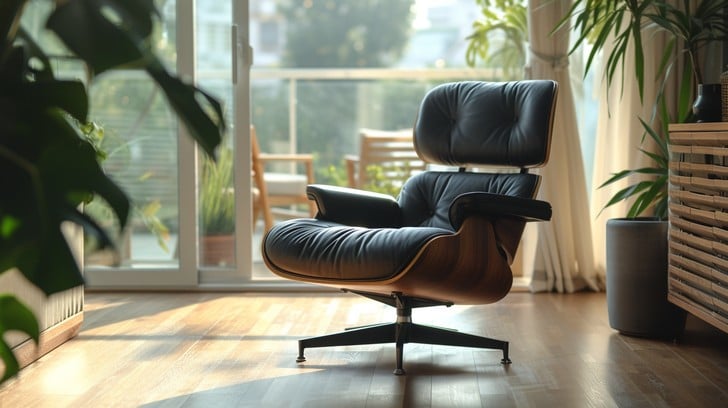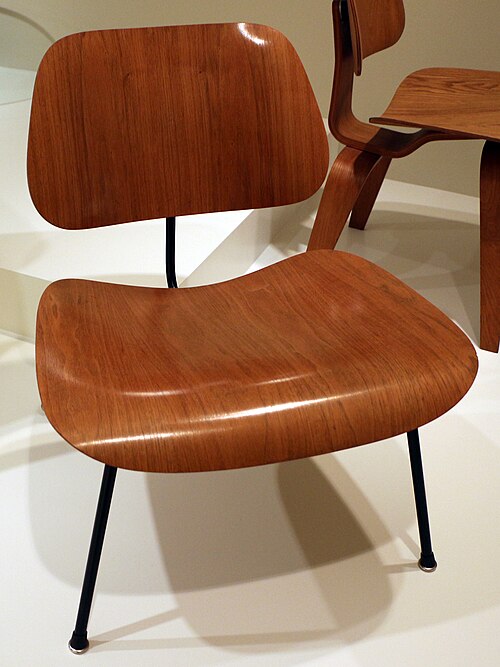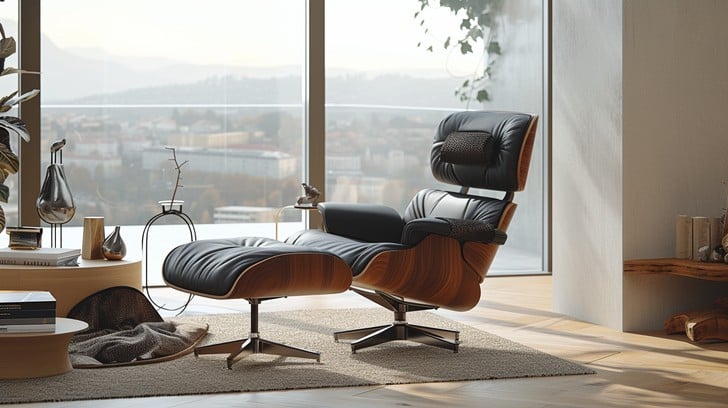DCM vs LCW vs Lounge: A Guide to Eames Plywood Chairs

If you've spent any time looking at Eames furniture, you've seen these abbreviations: DCM, LCW, DCW, LCM. They sound like model numbers, and technically they are, but they're also a classification system that tells you exactly what you're looking at—if you know how to read them.
The letters break down simply:
- D = Dining height
- L = Lounge height (lower)
- C = Side chair (no arms)
- W = Wood base
- M = Metal base
So a DCM is a Dining height, side Chair with a Metal base. An LCW is a Lounge height, side Chair with a Wood base. Once you understand the code, every Eames plywood chair name makes sense.
But here's what makes this interesting: of all the plywood chairs Charles and Ray designed, one model outsold everything else so completely that it's not even close. In 1952, Herman Miller sold 21,526 plywood chairs total. Of those, 18,000 were DCMs. That's 83% of all plywood chair sales going to a single model.
The DCM became so synonymous with "Eames chair" that a 1961 Herman Miller advertisement confidently predicted it would still be famous a hundred years later. They were right—we're only sixty years in and it's still in production.
The DCM: The Chair That Defined "Eames"
 Photo: CC BY 3.0
Photo: CC BY 3.0
The DCM launched in 1946 as part of the original plywood group. It's a dining chair—designed to sit at table height—with a tubular steel frame instead of wooden legs. That metal base made it lighter and more visually delicate than the all-wood versions, while the molded plywood seat and back provided the comfort the Eameses had spent years engineering.
Specifications:
- Height: 75.88 cm (29.9 inches)
- Width: 49.53 cm (19.5 inches)
- Seat height: Approximately 17 inches
- Construction: Five layers of molded plywood with tubular steel frame
- Shock mounts: Rubber discs between seat/back and frame
The shock mounts were crucial. Charles and Ray adapted industrial shock-absorbing technology—previously used only in machinery—for furniture. Thick rubber discs connected the wooden seat and back to the metal frame, providing flexibility and resilience. When you sit down, there's a slight give. Not enough to feel unstable, but enough that the chair responds to your body instead of forcing your body to conform to it.
The metal frame comes in either chrome or black finish. Early models (1946-1949) were manufactured by Evans Products Company before Herman Miller bought the operation. These first-generation chairs have distinctive round attachment points where the frame connects to the backrest. Later generations changed to different connector shapes, which helps with dating vintage pieces.
Time magazine eventually named the DCM the Best Design of the 20th Century. The Victoria and Albert Museum called it "the most imitated chair of the mid-twentieth century." Not the lounge chair. The dining chair.
Why did it dominate sales so thoroughly? Timing, partly. Post-war America needed furniture. The old 18th and 19th-century styles still dominated most homes, but new materials were becoming luxury in ways people hadn't seen before. The DCM looked modern without being alienating. It used plywood—a material people recognized—but shaped it in ways that felt futuristic.
Herman Miller's marketing helped. They positioned the DCM as the centerpiece of the plywood group. Their showrooms displayed it prominently. Their advertisements featured it. And it worked. By 1952, for every other plywood chair Herman Miller sold, they sold four DCMs.
The LCW: Lower, Wider, Discontinued (Then Revived)
_Chair_by_Charles_and_Ray_Eames,_Honolulu_Museum_of_Art_4410.1.jpg) Eames LCW Chair at Honolulu Museum of Art
Eames LCW Chair at Honolulu Museum of Art
The LCW is the lounge version of the DCW—same all-wood construction, but lower to the ground and slightly wider. It's designed for relaxing rather than dining, with a more reclined sitting position.
Specifications:
- Height: 69.53 cm (27.4 inches)
- Width: 56.52 cm (22.2 inches)
- Construction: Five layers of molded plywood throughout
- Support: Two curved plywood legs of different sizes, plus molded spine
- Shock mounts: Large oval shape on early versions
The LCW launched in 1947, a year after the DCM. It uses the same five-layer molded plywood construction but with wooden legs instead of metal. The entire chair—seat, back, spine, legs—is plywood, though not from a single piece. Charles and Ray had tried making chairs from one continuous sheet of plywood back in 1940 for the MoMA "Organic Design in Home Furnishings" competition, but the technology didn't exist yet. The plywood kept cracking at the sharp curves.
Instead, they made separate components and connected them with those rubber shock mounts. The result looked like it could be one flowing piece of wood, even though it was actually five separate molded forms carefully joined together.
The LCW is noticeably lower than its dining-height siblings. If you've never seen one in person, the first impression is often surprise at how close to the ground it sits. Some people jokingly call it the "Low Chair Wood" instead of "Lounge Chair Wood" because of this. Next to a standard dining chair, the difference is dramatic—the LCW puts you in a much more reclined, casual position.
Early versions (1946-1950) were made by Evans Products Company. These first-generation chairs have distinctive features: no feet on the wooden leg ends, a long oval shock mount connecting the backrest to the spine, and sometimes a screw pattern of 5-2-5 on the underside (five screws on top, two in middle, five on bottom). Some early examples were sealed with melamine, which turned out to be a mistake—it reacted with sunlight and turned white.
Herman Miller bought the rights in 1949 and made their own refinements. They added small aluminum feet to the base of the legs. They kept producing the LCW through the early 1950s, but sales couldn't compete with the DCM and LCM. By 1957, Herman Miller discontinued it.
Then in 1994, they brought it back. The revived LCW has modern labels and one significant design change: instead of the large oval shock mount on the backrest, it uses two separate circular mounts. Current versions are available in multiple wood finishes including ash, walnut, and Santos palisander.
The LCW is now in permanent collections at the San Francisco Museum of Modern Art, the Victoria and Albert Museum, the National Museum of American History, and about a dozen other major museums. Which is interesting, because it was discontinued as a commercial failure.
The DCW and LCM: The Other Two
The DCW (Dining Chair Wood) and LCM (Lounge Chair Metal) complete the original plywood group quartet, though they get less attention than the DCM and LCW.
The DCW is essentially the all-wood version of the DCM—same dining height, same upright position, but with wooden legs instead of a metal frame. It was available in multiple wood veneers (calico ash, birch, walnut) and also offered with leather or slunk skin upholstery in some versions.
Herman Miller discontinued the DCW in 1953, even earlier than the LCW. The metal-based DCM and LCM had a more "modern" appearance with their combination of materials, and they outsold the all-wood versions significantly. When Herman Miller brought back the plywood chairs in 1994 as part of their "Home Classics" range, they revived the DCW along with the LCW.
DCW Specifications:
- Height: 75.88 cm (29.9 inches)
- Width: 49.53 cm (19.5 inches)
- All-wood construction with molded plywood legs and spine
- First generation: screw pattern of 5-2-5, oval shock mount
The LCM is the lounge-height version with a metal frame—lower and wider than the DCM, with that more reclined sitting position. It's been in continuous production since 1946, never discontinued, making it one of the longest-running furniture designs in Herman Miller's catalog.
The LCM shares the DCM's metal frame construction but sits lower and wider like the LCW. It combines the "modern" appeal of mixing materials (wood and metal) with the casual comfort of lounge-height seating. This combination kept it selling steadily even when the all-wood versions fell out of favor.
LCM Specifications:
- Lower seat height than DCM (lounge position)
- Wider seat than DCM
- Metal frame construction
- Five layers of molded plywood for seat and back
The Lounge Chair: A Different Animal Entirely

When people say "Eames lounge chair" today, they usually mean the 1956 leather and rosewood chair—the iconic three-shell recliner with the ottoman. That's officially the Eames Lounge Chair and Ottoman, models 670 and 671.
It's not part of the plywood group, even though it uses plywood construction. It's a completely different design family. The DCM, LCW, DCW, and LCM all came out in 1946-1947 as affordable, mass-produced seating. The 1956 lounge chair was the Eameses' first venture into luxury furniture—expensive, handcrafted, designed for comfort above all else.
The plywood chairs used five layers. The lounge chair used five layers initially, then switched to seven in the 1970s for added stability. The plywood chairs cost around $20-30 in 1946 dollars. The lounge chair cost $310 in 1956—roughly the price of a decent used car.
So when you see "LCW" or "LCM," you're looking at the 1940s plywood group. When you see "Eames Lounge Chair" without the letter codes, you're probably looking at the 1956 luxury design. They're related through construction technique and designers, but they serve completely different purposes and price points.
How to Tell Them Apart at a Glance
If you're looking at photos online or vintage pieces in person, here's the quick identification method:
Metal frame or wood legs?
- Metal = DCM or LCM
- Wood = DCW or LCW
High or low?
- Upright, table-height position = DCM or DCW (dining)
- Lower, reclined position = LCM or LCW (lounge)
Width check:
- Narrower (about 19.5 inches) = DCM or DCW
- Wider (about 22 inches) = LCM or LCW
The lounge versions sit noticeably lower and feel wider when you're looking at them. The dining versions put you in an upright position suitable for sitting at a table. If you're not sure from photos, the width measurement usually settles it—the lounge chairs are about 2.5-3 inches wider to accommodate that more relaxed sitting position.
Why the Naming System Matters
Understanding these abbreviations helps when you're shopping for vintage pieces or looking at replicas. Sellers sometimes mislabel chairs, either through ignorance or intentionally. If someone's selling an "LCW" but the photo shows a metal frame, you know something's wrong. If dimensions don't match the stated model, that's a red flag.
It also helps with understanding value. DCMs are common because they sold so well—finding vintage examples isn't difficult, though finding them in excellent condition is another matter. LCWs and DCWs are rarer because they were discontinued for decades. First-generation Evans-produced versions of any model command premium prices from collectors.
The 1962 counterfeit warnings that Charles and Ray took out weren't just about the lounge chair. The plywood chairs were being copied too, particularly the popular DCM. Knowing the specific details—shock mount shapes, screw patterns, connector styles—helps authenticate pieces and date them to specific production periods.
The Generations Question
You'll often see vintage sellers talking about "generations" of Eames chairs—first generation, second generation, and so on. These aren't official designations Charles and Ray used. They're collector terms describing the natural evolution of the designs over decades of production.
For plywood chairs, the generations generally break down by manufacturer and specific design changes:
First Generation (1946-1949): Evans Products Company production. Round attachment points on metal frames, oval shock mounts, solid heavy metal rods, screw-in "domes of silence" feet. Evans labels or medals.
Second Generation (1950-1960s): Early Herman Miller production. Oval connectors evolved, shock mounts slightly refined, aluminum feet added to wood-leg versions, five-two-four screw pattern on some models. Black or silver Herman Miller labels.
Later Generations: Various refinements through the 1960s-2000s. Connector shapes changed, shock mounts got smaller, glide/feet designs evolved, new wood veneer options added. Label styles changed repeatedly.
The generation system helps with dating and authentication, but it's not an exact science. Herman Miller made changes gradually, not in sudden overhauls. A chair might have some second-generation features and some third-generation features because it was made during the transition period.
What Made the Plywood Group Revolutionary
Looking at these chairs now, it's easy to miss why they mattered so much. They're design classics, sure, but they're also just chairs. Pleasant to look at, comfortable to sit in, well-made. What's revolutionary about that?
Context helps. In 1946, most American furniture was still heavily influenced by 18th and 19th-century European styles. Ornate, traditional, made from solid wood in conventional ways. The Eameses took plywood—a material associated with cheap construction and military applications—and turned it into something that belonged in museums.
The molding process itself was innovative. Charles and Ray spent years developing their "Kazaam machine" (named after stage magicians) to bend plywood into compound curves using heat, pressure, and glue. They'd experimented with balloons and bicycle pumps in their apartment, trying to figure out how to achieve the shapes they wanted.
The result was furniture that looked organic and flowing but was actually precisely engineered. The curves weren't decorative—they followed the body's contours. The shock mounts weren't a design flourish—they were functional components that made the chairs flex with your movements.
And they could be mass-produced. That was crucial. Charles and Ray weren't trying to create one-off art pieces. They wanted furniture that could be manufactured at scale and sold at reasonable prices. The plywood group achieved that. By 1952, Herman Miller was producing thousands of these chairs annually.
Current Production and Availability
Herman Miller still manufactures the DCM and LCM today. They've been in continuous production since 1946—seventy-seven years and counting. The LCW and DCW were revived in 1994 and remain available.
Current versions use modern labeling, refined manufacturing processes, and expanded wood veneer options. The essential design hasn't changed. You can still buy a DCM that's fundamentally the same chair that sold 18,000 units in 1952.
New Herman Miller plywood chairs typically run $400-600 depending on model and finish. Vintage examples in good condition sell for similar prices or higher, depending on generation, rarity, and condition. First-generation Evans pieces in excellent shape can fetch $800-1,500 or more from collectors.
Vitra produces these chairs for the European market under license from the Eames Office. Their versions are equally authentic but sometimes use slightly different wood finishes and label styles.
Replicas exist at every price point, as they do for most Eames designs. Quality varies enormously. Some manufacturers make well-constructed versions that follow the original specifications closely. Others cut corners on materials and construction. The price usually indicates which you're getting, though not always.
The Chairs That Almost Nobody Talks About
The DCM, LCW, DCW, and LCM weren't the only plywood pieces Charles and Ray designed. The plywood group also included:
The Plywood Coffee Table (CTW): A low table with the same molded plywood top and wooden legs as the DCW/LCW. Discontinued decades ago, rarely seen.
The Plywood Dining Table (DTW): Table-height version of the same construction. Also discontinued, even rarer than the coffee table.
Various occasional tables (CTM, OTW): Small side tables using plywood tops with metal or wood bases. Mostly discontinued, occasionally found in vintage markets.
The Children's Chair: A smaller version of the plywood chairs designed for kids. Still produced today, though less famous than the adult versions.
The Folding Screen (FSW): A six-panel room divider made from molded plywood. Beautiful, rare, extremely expensive when you can find one.
These ancillary pieces didn't sell nearly as well as the chairs. Herman Miller discontinued most of them within a decade. The chairs—particularly the DCM and LCM with their modern metal-and-wood aesthetic—were what the market wanted.
Why the DCM Dominated
So why did the DCM outsell everything else by such a massive margin?
Part of it was Herman Miller's marketing. They positioned it as the flagship. Part of it was practicality—people needed dining chairs more than lounge chairs, and the metal base felt more contemporary than all-wood construction.
But there's also something about the DCM's specific proportions and presence that worked. It was modern but not alienating. It looked expensive but wasn't. It fit both contemporary and traditional interiors. The metal frame gave it visual lightness, while the wood seat and back kept it warm and approachable.
The V&A Museum's assessment is probably accurate: it became the most imitated chair of the mid-20th century because it successfully balanced innovation with accessibility. It was different enough to feel new, familiar enough to feel comfortable.
Charles and Ray spent years developing the technology to make these chairs. They experimented, failed, refined, tested, and started over countless times. The DCM was the result of all that work—a chair that looked simple and inevitable but required enormous effort to achieve.
Eighteen thousand units in 1952. Still in production in 2026. Still recognizable, still comfortable, still relevant. That's the measure of successful design—not that it impresses people when it's new, but that it keeps working decades later when everyone's forgotten it was ever supposed to be innovative.